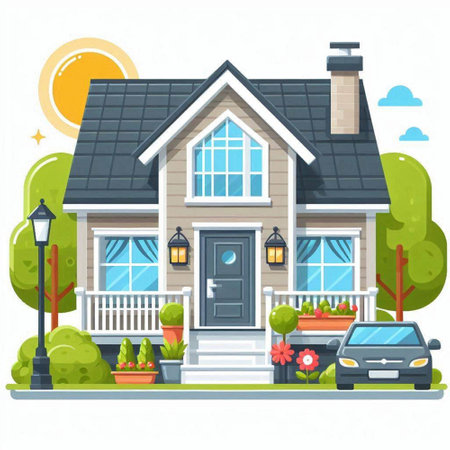Introduction: The Rise of Affordable Smart Home Tech
Smart home technology is no longer just a luxury for the tech-savvy or wealthy. Over the past few years, affordable smart home solutions have become increasingly accessible, transforming the way Americans live, work, and manage their households. From voice-activated assistants to energy-saving thermostats, today’s smart devices are designed with user-friendly features and wallet-friendly price tags. This shift has made it easier for families across the country to enjoy greater convenience, improved security, and better energy efficiency without breaking the bank. As prices continue to drop and options expand, smart home tech is quickly becoming a game changer for American households of all sizes and budgets, helping everyone from busy parents to renters and first-time homeowners streamline their daily routines and enhance their quality of life.
Essential Smart Devices That Wont Break the Bank
When it comes to building an affordable smart home, you dont have to invest in high-end gadgets or a complex setup. There are plenty of budget-friendly devices that can instantly upgrade your living space and fit seamlessly into your daily routine. Here are some must-have smart devices that combine value and convenience for every household.
Smart Bulbs: Light Up Your Home Without High Costs
Smart bulbs are one of the easiest and most cost-effective ways to start your smart home journey. With brands like Wyze, Sengled, and Philips Hue offering bulbs for under $20, you can control lighting through your phone or voice assistants. Schedule lights to turn on before you get home, dim them for movie night, or set color scenes for special occasions—all without touching a switch.
Smart Plugs: Affordable Automation for Any Appliance
Smart plugs make any standard device “smart” by allowing remote control via app or voice command. Plug in lamps, coffee makers, or fans to automate routines or cut down on energy usage. Many top-rated options from TP-Link Kasa and Amazon Basics cost less than $15 each, making them a budget-friendly way to modernize your home.
Smart Speakers: Central Hubs for Convenience
Entry-level smart speakers like Amazon Echo Dot or Google Nest Mini (often found for $30 or less) act as the brains of your smart home. Use them to play music, set timers, answer questions, manage shopping lists, or control other connected devices—all hands-free. Their compact size and affordability make them perfect for bedrooms, kitchens, or even dorm rooms.
Budget-Friendly Device Comparison Table
| Device Type | Popular Brand | Average Cost (USD) | Main Features |
|---|---|---|---|
| Smart Bulb | Sengled Smart LED | $10–$15 | Voice/app control, scheduling, dimming |
| Smart Plug | Kasa Smart Plug Mini | $12–$15 | Remote on/off, scheduling, compact design |
| Smart Speaker | Echo Dot (5th Gen) | $25–$30 | Voice assistant, music streaming, device hub |
How These Devices Fit Into Everyday Life
Imagine waking up to soft lighting instead of a blaring alarm clock, having your coffee ready with a scheduled smart plug, and asking your speaker about today’s weather while you get dressed. Budget-friendly smart devices bring small but meaningful improvements to daily life—making routines easier and your home more comfortable without overspending.

3. DIY Installation Tips and Tricks
Setting up your own smart home doesn’t have to be intimidating—or expensive. By tackling installation yourself, you can save on professional fees and customize your setup to fit your needs. Here are some easy steps and helpful tips for a smooth DIY experience:
Start Simple with Plug-and-Play Devices
Begin with user-friendly products like smart plugs, bulbs, or speakers. These usually require nothing more than plugging them in and following the in-app instructions. Many brands offer guided setup through their mobile apps, making the process straightforward even for first-timers.
Follow Manufacturer Instructions Closely
Always read the instruction manual or watch official online tutorials before starting. Most affordable smart devices come with step-by-step guides that walk you through the process. Don’t skip this step—it saves time and prevents mistakes.
Prep Your Home Wi-Fi Network
A stable internet connection is essential for smart home tech. Make sure your Wi-Fi covers all the areas where you plan to install devices. You might need to rename your network for easier device recognition or adjust router settings for optimal performance.
Use Labeling and Organization
As you add more devices, label each one physically or within your chosen app. This helps keep everything organized and easy to control, especially when using voice assistants or automation routines.
Troubleshooting Made Easy
If you hit a snag, check online forums, YouTube tutorials, or the manufacturer’s support site. The smart home community is active and always willing to help newcomers solve common setup issues.
Upgrade Gradually
You don’t have to automate your entire house at once. Start with one room or system, get comfortable with installation, then expand as your budget allows. This approach keeps things manageable and wallet-friendly while building your dream smart home.
Improving Safety and Security on a Budget
Home security is a top priority for many American households, but the cost of traditional alarm systems and surveillance can be overwhelming. Fortunately, smart home technology has made it easier and more affordable to protect your property. Today’s budget-friendly smart locks, video doorbells, and other security devices offer robust features without breaking the bank.
Smart Locks: Affordable Entry Protection
Smart locks have become an accessible way to upgrade your home’s security. Many options under $100 allow you to lock or unlock doors remotely, set temporary codes for guests, and receive alerts when someone enters. Brands like Wyze and August offer reliable smart locks that are easy to install and compatible with most standard doors.
Video Doorbells: See Who’s at Your Door—Anywhere
Video doorbells provide peace of mind by letting you see and speak with visitors via your smartphone. Affordable models from Ring or Blink often start around $50–$100, providing high-definition video, motion detection, and cloud storage options. These devices are particularly helpful for monitoring package deliveries or deterring porch pirates.
Other Budget-Friendly Security Tech
Beyond locks and doorbells, there are several cost-effective security gadgets worth considering. Wi-Fi-enabled indoor cameras can be found for as little as $20–$40 each, offering live feeds and two-way audio. Smart sensors for doors and windows notify you instantly if they’re opened unexpectedly. Some brands even bundle these items into starter kits for extra savings.
| Device Type | Popular Brands | Price Range (USD) |
|---|---|---|
| Smart Lock | Wyze, August | $60–$120 |
| Video Doorbell | Ring, Blink | $50–$100 |
| Indoor Camera | Kasa, Wyze | $20–$40 |
| Door/Window Sensor | Simplisafe, Eufy | $15–$30 per sensor |
These affordable solutions make it possible for every household to enhance safety without stretching the budget. By mixing and matching devices according to your needs, you can build a custom security system that fits your lifestyle—and your wallet.
5. Energy Efficiency and Cost Savings
One of the standout advantages of affordable smart home solutions is their ability to help American households reduce both energy consumption and utility bills. Smart thermostats, such as the Google Nest or ecobee, learn your familys routines and automatically adjust heating and cooling schedules for maximum efficiency. This means your HVAC system only works when you truly need it, keeping your home comfortable while preventing wasted energy. In fact, many U.S. homeowners have reported annual savings of up to 10-15% on heating and cooling costs after installing a smart thermostat.
In addition to thermostats, energy-monitoring devices are becoming increasingly popular in budget-friendly smart homes. These gadgets plug into your existing outlets or connect directly to your electrical panel, providing real-time feedback on how much electricity each appliance or room is using. With this data at your fingertips—often accessible through a smartphone app—you can easily identify energy-hogging devices and make smarter decisions about when and how to use them. For instance, you might discover that your old refrigerator is costing more than you thought, prompting a switch to a more efficient model.
Many utility companies across the U.S. also offer rebates or incentives for homeowners who install certified smart thermostats and energy-saving devices, making these upgrades even more affordable. By taking advantage of these programs and leveraging smart technology, families can enjoy a comfortable home environment while making a positive impact on their monthly expenses—and the planet.
6. Making It All Work Together: Affordable Ecosystems
When building a smart home on a budget, making sure your devices work together seamlessly is key. The good news is, you don’t have to spend big bucks to create a connected ecosystem. Here are some practical tips for choosing compatible devices, finding inexpensive hubs, and using free apps to keep everything running smoothly.
Tips for Choosing Compatible Devices
Start by picking products that support popular standards like Wi-Fi, Zigbee, or Z-Wave—these protocols help devices communicate with each other even if they’re from different brands. Look for compatibility badges such as “Works with Alexa,” “Works with Google Assistant,” or “Apple HomeKit.” Sticking to one or two ecosystems can also reduce headaches down the road. Before buying, check online forums and reviews to confirm that devices play nicely together.
Inexpensive Hubs That Do the Job
You don’t need an expensive hub to connect your smart home. Devices like Amazon Echo Dot or Google Nest Mini often double as hubs, letting you control lights, plugs, and thermostats with your voice or phone. If you need more advanced features, consider affordable options like Samsung SmartThings Hub or Hubitat Elevation—both offer broad compatibility without breaking the bank.
Free Apps for Seamless Integration
Many manufacturers provide free apps that allow you to control their devices, but you can go further by using third-party apps like Google Home or Apple Home app for centralized management. For automation, check out IFTTT (If This Then That), which lets you link actions between various brands—at no cost. These tools make it easy to set up routines and scenes without paying extra fees.
Smart Tips for Success
- Before buying anything new, use online compatibility checkers to avoid surprises.
- Stick to major brands when starting out—they usually offer better long-term support.
- Take advantage of user communities on Reddit or Facebook Groups for troubleshooting advice and creative ideas.
The Bottom Line
A fully integrated smart home doesn’t require a high price tag. By focusing on compatibility, leveraging budget-friendly hubs, and utilizing free apps, you can enjoy modern convenience and automation without overspending. Plan ahead and build your system step by step—you’ll be surprised how much value you can get for less!
7. Conclusion: Smart Living for Every American Household
Embracing smart home technology doesn’t have to be a luxury reserved for a select few. With so many affordable and user-friendly options available today, every American household can take the first steps toward smarter, more convenient living without worrying about breaking the bank. Remember, you don’t need to overhaul your entire home at once—start small with a few budget-friendly devices that fit your needs and lifestyle. As you get comfortable and see the benefits, you can gradually expand your system over time. The key is to focus on solutions that add genuine value to your daily routine, whether it’s saving energy, enhancing security, or simply making life more enjoyable. So go ahead and explore the possibilities of smart living—it’s more accessible than ever and designed to grow with you. Your journey toward a connected, efficient, and budget-conscious home starts now!

